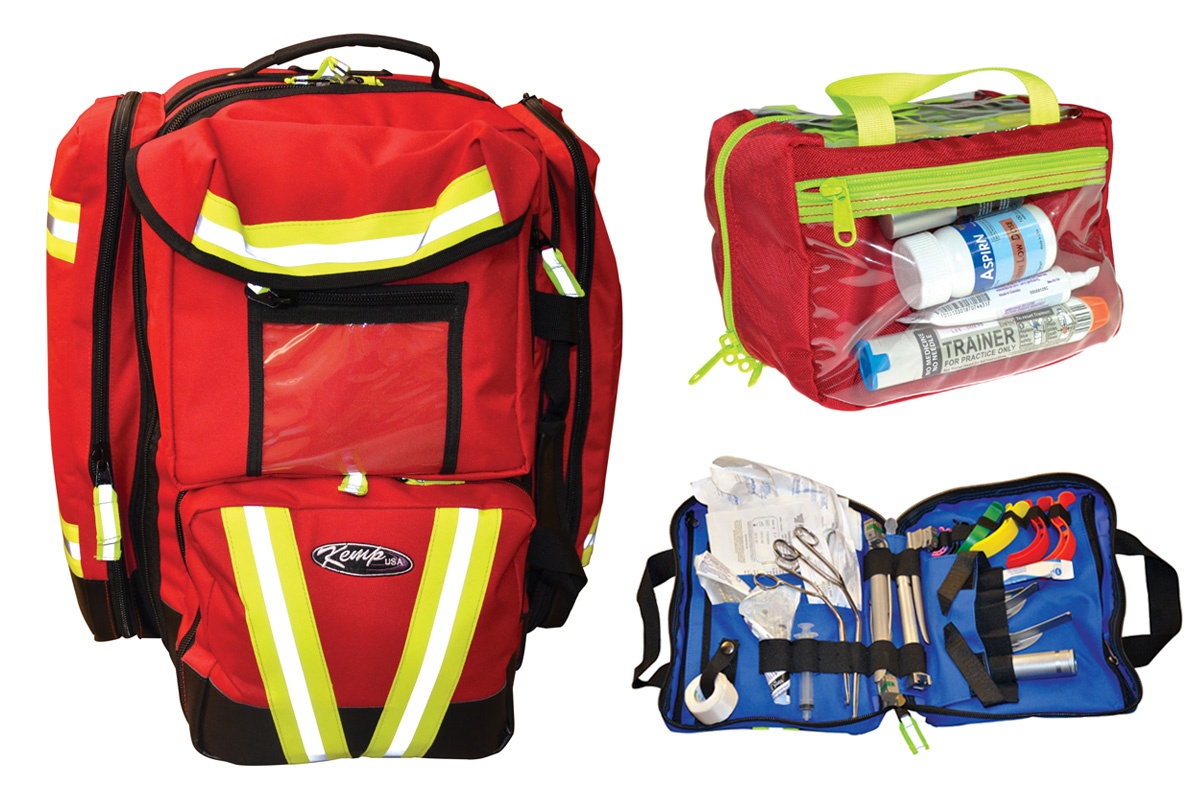
Pictured above, left: Original First-in Bag module (01-44-0115); right top: Demo Dose® simulated medications module; right bottom: airway module for First in Bag. The modules come fully stocked. First-in Bag was demonstrated at EMSWorld Expo and at EMS Today Hands-On Experience booth.
The National Registry of Emergency Medical Technicians (NREMT) recently made changes to its Paramedic Psychomotor Exam. The NREMT has moved away from testing isolated skills and placed an increased emphasis on critical thinking skills, with the addition of a complex scenario for them to investigate and treat. Considering that paramedics regularly work with minimal information, this new testing procedure will further reduce the disparity in knowledge between professionals and students. (For more about the changes to the NREMT exams, download our white paper.)
As part of its initiative to reach out and provide solutions to the EMS community, Pocket Nurse has developed a line of EMS First-in Bag solutions that contain the equipment listed in the NREMT Integrated Out of Hospital (IOOH) Scenario Essay to Skills Examiners (2016). Pocket Nurse’s EMS First-in Bag is designed to meet the needs of both initial EMS education and psychomotor examinations.
In the First-in Bag solution, Demo Dose Simulated Medications for EMS are packaged in the same way they are used in the field. This enhances the scenario, making it more realistic, and ensuring it runs smoother. By having the same types of EMS-specific medications, the First-in Bag is a solution that will work at a national level.
Simulation is a method, not a technology, and it can substitute or strengthen real patient care experience in a controlled environment (Gaba, 2007). Recognizing the importance of simulation in EMS education, the NREMT requires that all paramedic students demonstrate their competency in at least 20 scenarios during the laboratory phase of their education (NREMT, 2015).
Practicing as though we are in a real emergency situation is a key concept for effective simulation. Students need to perform their assessments and treatment with as much realism as possible. Pocket Nurse’s Demo Dose® Simulated Medicines provide for realistic medication administration without the risk associated with the actual medication. The modular design of Pocket Nurse’s First-in Bag helps to promote realism. The Simulated Patient tote contains disposable items that are applied to the simulated patient and then reused since each tote is individualized. Pocket Nurse’s EMS First-in Bag not only reduces restocking cost but increases realism in education.
 The First-in Bag is reusable for training as well, which reduces restocking costs. The treatment module and assessment module for each class gives students their own modules on each rotation.
The First-in Bag is reusable for training as well, which reduces restocking costs. The treatment module and assessment module for each class gives students their own modules on each rotation.
This is a guest post from J. Todd Vreeland, former project lead on the NREMT psychomotor exam. Vreeland is the owner of J. Todd Vreeland Consulting, committed to ensuring the protection of the public through high-quality EMS education and patient-centered delivery of out-of-hospital medical care.
For more information on the First-in Bag, see its product information at PocketNurse.com.
References:
Gaba, D. (2007). The Future of Simulation in Healthcare. Simulation in Healthcare, 126. DOI: 10.1097/01.SIH.0000258411.38212.32
National Registry of Emergency Medical Technicians. (2015). 2015 Paramedic Psychomotor Competency Portfolio. Appendix A. Retrieved from https://content.nremt.org/static/documents/Paramedic_Psychomotor_Competency_Portfolio_Manual_v4.pdf
National Registry of Emergency Medical Technicians. (2016). NREMT Integrated Out-of-hospital Scenario Essay to Skills Examiners. 97-99. Retrieved from https://content.nremt.org/static/documents/Advanced%20Level%20Examination%20Coordinator%20Manual.pdf






